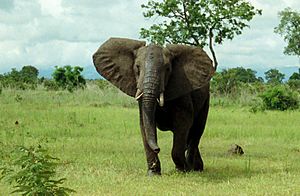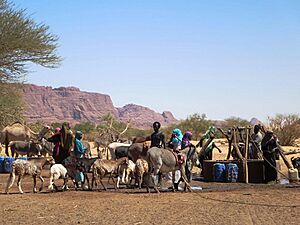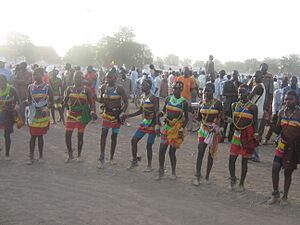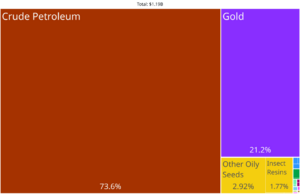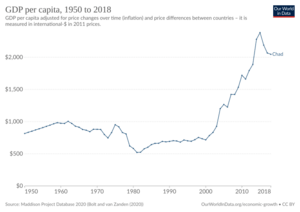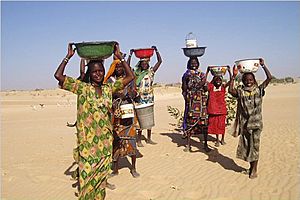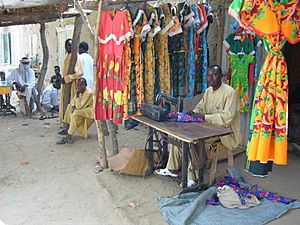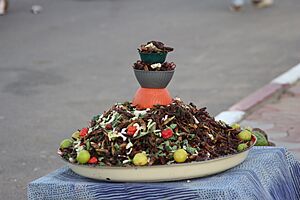Chad facts for kids
Quick facts for kids
Republic of Chad
|
|
|---|---|
|
|
|
|
Anthem:
|
|
| Capital and largest city
|
N'Djamena 12°06′19″N 15°02′41″E / 12.10528°N 15.04472°E |
| Official languages | |
| Ethnic groups
(2009)
|
|
| Religion
(2020)
|
|
| Demonym(s) | Chadian |
| Government | Unitary semi-presidential republic under a hereditary dictatorship |
| Mahamat Déby | |
| Allamaye Halina | |
| Legislature | National Transitional Council |
| Independence from France | |
|
• Colony established
|
5 September 1900 |
|
• Autonomy granted
|
28 November 1958 |
|
• Sovereign state
|
11 August 1960 |
| Area | |
|
• Total
|
1,300,000 km2 (500,000 sq mi) (20th) |
|
• Water (%)
|
1.9 |
| Population | |
|
• 2024 estimate
|
19,093,595 (66th) |
|
• Density
|
14.4/km2 (37.3/sq mi) |
| GDP (PPP) | 2023 estimate |
|
• Total
|
|
|
• Per capita
|
|
| GDP (nominal) | 2023 estimate |
|
• Total
|
|
|
• Per capita
|
|
| Gini (2022) | ▼ 37.4 medium |
| HDI (2022) | low · 189th |
| Currency | Central African CFA franc (XAF) |
| Time zone | UTC+1 (WAT) |
| Driving side | right |
| Calling code | +235 |
| ISO 3166 code | TD |
| Internet TLD | .td |
Chad ( chad), officially the Republic of Chad, is a country in Africa that does not have a coastline. It is located where North Africa and Central Africa meet. Chad shares borders with Libya to the north, Sudan to the east, the Central African Republic to the south, Cameroon and Nigeria to the southwest, and Niger to the west.
Chad has a population of about 19 million people. About 1.6 million of these people live in the capital and largest city, N'Djamena. The country has different natural areas: a desert in the north, a dry Sahel region in the middle, and a more fertile Sudanian Savanna in the south. Lake Chad, which gives the country its name, is the second-largest wetland in Africa.
The official languages of Chad are Arabic and French. More than 200 different groups of people and languages can be found here. The main religions in Chad are Islam (55.1%) and Christianity (41.1%).
People started living in the Chad basin a very long time ago, around 7,000 BC. Over time, many kingdoms and empires grew and fell in Chad's Sahel region. They often controlled the important trans-Saharan trade routes. France took control of the area by 1920, making it part of French Equatorial Africa. Chad became independent in 1960, led by François Tombalbaye.
After independence, there were disagreements, leading to a long civil war starting in 1965. Later, different groups fought for control. Hissène Habré eventually took power. There was also a conflict with Libya from 1978 to 1987, which ended with help from France. In 1990, Idriss Déby overthrew Hissène Habré. With French support, Chad's army was modernized. From 2003, problems from the Darfur crisis in Sudan affected Chad, causing many Sudanese refugees to seek safety there.
During Idriss Déby's time as president, the Patriotic Salvation Movement held most of the power. After President Déby passed away in April 2021, his son Mahamat Déby took control of the government. Chad still faces challenges with political changes and attempted coups.
Chad is one of the poorest countries in the world. Many people live in poverty, working as farmers and herders. Since 2003, crude oil has become Chad's main export, replacing cotton. Chad is working to improve its human rights record and civil liberties.
Contents
Exploring Chad's Geography
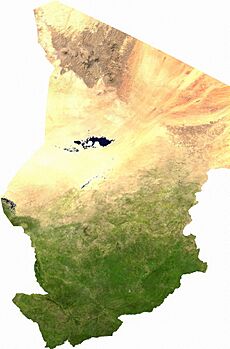
Chad is a very large country in north-central Africa. It covers about 1.28 million square kilometers (496,000 square miles). This makes it the twentieth-largest country in the world. Chad is a bit smaller than Peru and a bit larger than South Africa.
Chad is surrounded by other countries. To the north is Libya, to the east is Sudan, and to the west are Niger, Nigeria, and Cameroon. To the south is the Central African Republic. Chad's capital city, N'Djamena, is far from the sea. The nearest seaport is in Douala, Cameroon, about 1,060 kilometers (660 miles) away. Because it's so far from the ocean and has a lot of desert, Chad is sometimes called the "Dead Heart of Africa."
The country's main physical feature is a large basin. This basin is surrounded by the Ennedi Plateau and Tibesti Mountains in the north and east. The Tibesti Mountains include Emi Koussi, a volcano that is 3,414 meters (11,198 feet) tall. Lake Chad, which the country is named after, is what's left of a huge ancient lake. Even though it's much smaller now, it's still Africa's second-largest wetland.
Chad has different types of natural environments. These include savannas, grasslands, and woodlands. The tall grasses and marshes are great for birds, reptiles, and large mammals. Chad's main rivers, the Chari and Logone, flow through the southern savannas into Lake Chad.
Each year, a tropical weather system brings a wet season to Chad. This season lasts from May to October in the south and from June to September in the Sahel. This rainfall creates three main climate zones. The Sahara desert is in the northern part of the country. It gets very little rain, less than 50 millimeters (2 inches) per year. Only a few palm groves grow there.
South of the Sahara is the Sahel region. This area gets more rain, between 300 to 600 millimeters (12 to 24 inches) per year. Here, you'll find thorny bushes like acacias. Further south, the Sahel turns into the East Sudanian savanna. This zone gets over 900 millimeters (35 inches) of rain each year.
Amazing Wildlife in Chad
Chad's animals and plants change depending on the climate zones. In the Sahara desert, you'll mostly find date-palm groves in oases. In the Sahel region, there are palms and acacia trees. The southern part of Chad, called the Sudanic zone, has wide grasslands perfect for grazing animals. As of 2002, Chad was home to at least 134 types of mammals and 509 types of birds. There are also over 1,600 kinds of plants.
You can find elephants, lions, buffalo, hippopotamuses, rhinoceroses, giraffes, and many types of antelopes here. Other animals include leopards, cheetahs, hyenas, and various snakes. Sadly, the numbers of many large meat-eating animals have dropped a lot since the early 1900s.
One big problem is elephant poaching, especially in places like Zakouma National Park in the south. Poachers hunt elephants for their valuable ivory. A small group of West African crocodiles still lives in the Ennedi Plateau. This is one of the last known groups of crocodiles in the Sahara today.
Chad has also lost many trees like acacias, baobabs, and palm trees due to deforestation. This means wild animals lose their homes. Hunting and farming by more people also contribute to this problem. Animal populations like lions, leopards, and rhinos have fallen significantly.
Organizations like the Food and Agriculture Organization are working to help farmers and herders get along better in areas like Zakouma National Park. This helps promote sustainable development. As part of conservation efforts, over 1.2 million trees have been replanted. This helps stop the desert from growing and also helps the local economy. Acacia trees produce gum arabic, which can be sold, and fruit trees also provide income.
People and Cultures of Chad
Chad's population is estimated to be around 19 million people in 2024. A large part of the population, about 47%, is under 15 years old. The average life expectancy is 52 years. About 1.5 million people live in the capital city, N'Djaména.
People are not spread evenly across Chad. In the northern desert region, there are very few people. But in the Logone Occidental Region, there are many more. About half of Chad's population lives in the southern part of the country, which is the most crowded area.
City life is mostly in the capital, N'Djamena, where people work in business. Other important towns are Sarh, Moundou, Abéché, and Doba. These towns are growing quickly. Since 2003, many refugees from Sudan have come to eastern Chad because of war. This has created some challenges for the communities in the region.
Major Cities in Chad
Here are some of Chad's largest cities:
| Rank | City | Population | Region | |
|---|---|---|---|---|
| 1993 Census | 2009 Census | |||
| 1. | N'Djaména | 530,965 | 951,418 | N'Djaména |
| 2. | Moundou | 99,530 | 137,251 | Logone Occidental |
| 3. | Abéché | 54,628 | 97,963 | Ouaddaï |
| 4. | Sarh | 75,496 | 97,224 | Moyen-Chari |
| 5. | Kélo | 31,319 | 57,859 | Tandjilé |
| 6. | Am Timan | 21,269 | 52,270 | Salamat |
| 7. | Doba | 17,920 | 49,647 | Logone Oriental |
| 8. | Pala | 26,116 | 49,461 | Mayo-Kebbi Ouest |
| 9. | Bongor | 20,448 | 44,578 | Mayo-Kebbi Est |
| 10. | Goz Beïda | 3,083 | 41,248 | Sila |
Diverse Ethnic Groups
Chad is home to over 200 different ethnic groups. This creates a very rich and varied society. While the government tries to unite everyone, for most Chadians, their local or regional group is still very important.
People in Chad can be grouped by where they live. In the south, you'll find settled people like the Sara, who are the largest ethnic group. In the middle Sahel region, settled people live alongside nomadic groups, like the Arabs, who are the second largest ethnic group. The north is mostly home to nomads, especially the Toubous.
Languages Spoken in Chad
Chad has two official languages: Arabic and French. However, more than 100 other languages are spoken across the country! Many of these languages belong to the Chadic language family. Chad also has languages from the Central Sudanic, Maban, and Niger-Congo families.
Because Arab traders and merchants have played a big role in local communities, Chadian Arabic has become a common language that many people use to communicate.
Religions in Chad
Chad is a country with many different religions. According to a 2010 study, about 52–58% of the people are Muslim, and 39–44% are Christian. Among Christians, about 22% are Catholic and 17% are Protestant.
Islam is practiced in many ways in Chad. For example, many Muslims follow Sufi groups, especially the Tijaniyah order. This order often mixes in some local African religious traditions. A small number of Muslims in Chad follow more strict practices.
Roman Catholics are the largest Christian group. Most Protestants are part of various evangelical Christian groups. There are also small communities of Baháʼí and Jehovah's Witnesses in Chad. These faiths were introduced after Chad became independent in 1960.
A small number of people still practice traditional local religions, often called Animism. These religions focus on ancestors and specific places. Christianity came to Chad with French and American missionaries. Like Islam in Chad, it sometimes blends with older, pre-Christian beliefs.
How Chad is Governed
Chad is divided into 23 regions since 2012. Before that, it had 14 prefectures. Each region has a governor chosen by the president. These regions are then divided into 61 departments, and these departments are split into 200 sub-prefectures. Finally, these sub-prefectures are made up of 446 smaller areas called cantons.
The government plans to replace the cantons with "rural communities." The goal is to have local people more involved in their own development. The constitution says that each area should have elected local assemblies. However, local elections have not happened yet and have been delayed many times.
Chad's Economy and Daily Life
Chad is one of the poorest countries in the world. About 80% of its people live below the poverty line. The average income per person was estimated at about US$1,651 in 2009. Chad uses the Central African CFA franc as its money.
For many years, civil wars made it difficult for foreign companies to invest in Chad. But since 2000, major investments in the oil industry have started. This has greatly improved Chad's economic future.
Most people in Chad, over 80%, make a living by farming and raising animals. What they grow and where they keep their animals depends on the local climate. The southernmost 10% of Chad has the most fertile land, producing a lot of sorghum and millet. In the Sahel, only tougher types of millet grow, and the harvests are smaller. However, the Sahel is great for raising large herds of cattle, goats, sheep, donkeys, and horses. The scattered oases in the Sahara desert only support a few dates and beans.
Cities in Chad face challenges with basic services. Only about 48% of city residents have access to clean drinking water, and only 2% have basic sanitation.
Before the oil industry grew, cotton was Chad's main industry. It made up about 80% of the country's export earnings. Cotton is still an important export today. Other important exports include cattle and gum arabic.
Chad has made some progress in reducing poverty. The national poverty rate went down from 55% in 2003 to 47% in 2011. However, the total number of poor people increased from 4.7 million in 2011 to 6.5 million in 2019. By 2018, about 4 out of 10 people still lived below the poverty line.
Chad's Rich Culture
Chad has a very rich culture because of its many different peoples and languages. The government actively supports Chadian culture. They have opened the Chad National Museum and the Chad Cultural Centre. Chad observes six national holidays each year. They also celebrate Christian holidays like Easter Monday and Muslim holidays like Eid ul-Fitr, Eid ul-Adha, and Eid Milad Nnabi.
Chadian Cuisine
Millet is the main food in Chadian cuisine. It's used to make balls of paste that are dipped in sauces. In the north, this dish is called alysh, and in the south, it's called biya. Fish is also very popular. It's often prepared as salanga (sun-dried and smoked fish) or banda (smoked large fish). Carcaje is a popular sweet red tea made from hibiscus leaves. In the south, people enjoy alcoholic drinks like millet beer. This beer is called billi-billi if made from red millet and coshate if made from white millet.
Music of Chad
The music of Chad uses many different instruments. Some examples are the kinde, a type of bow harp; the kakaki, a long metal horn; and the hu hu, a stringed instrument that uses calabashes to make sound louder. Some instruments are more common with specific ethnic groups. For example, the Sara people like whistles, balafons, harps, and kodjo drums. The Kanembu combine drum sounds with flute-like instruments.
The music group Chari Jazz started in 1964 and helped create Chad's modern music scene. Later, groups like African Melody and International Challal tried to mix modern and traditional styles. Popular groups like Tibesti have stayed closer to their roots, using sai, a traditional music style from southern Chad. For a long time, modern music wasn't very popular in Chad. But since 1995, more interest has grown, and CDs and audio cassettes by Chadian artists are now more common.
Chadian Literature
Like in other Sahelian countries, literature in Chad has faced challenges. Many Chadian writers have had to write from other countries. Their works often focus on themes of political challenges and historical events. Since 1962, about 20 Chadian authors have written around 60 fiction books. Some well-known writers include Joseph Brahim Seïd, Baba Moustapha, Antoine Bangui, and Koulsy Lamko. In 2003, Chad's only literary critic, Ahmat Taboye, published a book to help more people, especially young people, learn about Chadian literature. This also helps because Chad doesn't have many publishing houses or ways to promote books.
Sports in Chad
Football (soccer) is the most popular sport in Chad. People eagerly follow the country's national team during international games. Some Chadian footballers have even played for teams in France. Basketball and freestyle wrestling are also widely played. In wrestling, athletes often wear traditional animal hides and cover themselves with dust.
Images for kids
-
Group of Kanem-Bu warriors. The Kanem–Bornu Empire controlled almost all of what is today Chad.
-
A Chadian soldier fighting for Free France during World War II. The Free French Forces included 15,000 soldiers from Chad.
-
Idriss Déby ruled Chad from 1990 until his death in 2021.
See Also
 In Spanish: Chad para niños
In Spanish: Chad para niños




